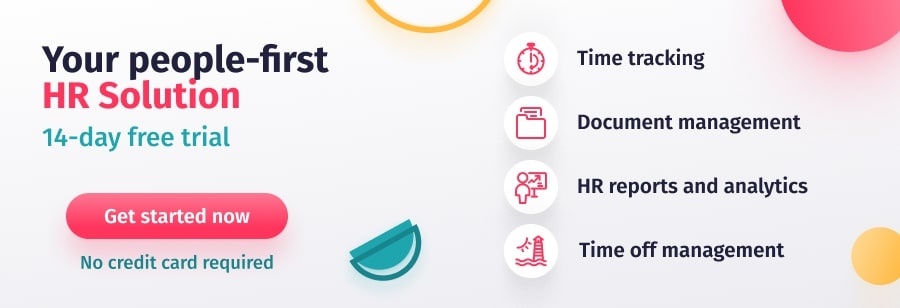Salary benchmarking is a critical component of any talent retention strategy. It involves gathering information on pay and benefits and comparing pay packages with those offered by competitors. Information is then used to calculate the average salary for specific roles within an organization.
Companies that conduct regular compensation benchmarking audits are more likely to attract top talent and develop a workplace culture of positivity that thrives and grows. They are also more likely to have reduced turnover rates, something which is more important than ever in the post-pandemic reality of the Great Resignation.
In this post, we will look at what salary benchmarking is and why it’s so important for your business. We will also share a step-by-step analysis to guide you through the process so that you can benchmark your salaries and attract and retain the right talent for your business.

What Is Salary Benchmarking?
Salary benchmarking, also known as compensation benchmarking, is the process of matching internal job descriptions with those of competitors in order to identify the market rate for each position. External data for analysis is usually gathered from a salary benchmarking survey or other market pay data sources.
It is then compared with a company’s internal salary database in order to establish whether the salaries offered for a position are in line with market rate expectations. Other factors including geographic location, company size, and education level are also taken into account when pay ranges are established.
Why Is Salary Benchmarking Important?
Conducting regular salary benchmarking exercises can benefit your business in a number of ways. Let’s take a look at some of the biggest advantages.
First and foremost, salary benchmarking helps you stay competitive in your market. By analyzing your pay rates and comparing them with industry averages you can offer potential candidates attractive yet realistic packages that help you attract and retain top talent. In other words, the salaries you offer are not so low that you put off potential candidates that could serve as a valuable asset in your company, or so low that existing employees are tempted to look elsewhere for opportunities.
They are also not so high that you exceed budgetary restrictions and risk having to make subsequent adjustments which can lead to employee dissatisfaction, poor employee engagement, and higher turnover costs. The right salary benchmarks can not only help you attract valuable candidates to your company, but they can also help you keep your employees happy, motivated, and valued.
Secondly, compensation benchmarking can give you an impartial understanding of pay expectations for different roles so that you can make better strategic decisions that result in sustainable growth for your company. It can guide decisions ranging from hiring, promotions, internal equity salary adjustments, and general compensation budget planning.
Compensation Benchmarking Process
There are three major steps in the salary benchmarking process: building a salary base, analyzing employee compensation rates, and establishing pay ranges.
Before you can start the process of analysis, you need to establish two important factors. The first is defining your internal positions and the key attributes of each role so that you have a basis for comparison. The second is deciding where you will be sourcing external pay data for comparison.
Once you have clarified these two important points you will be ready to begin.
Build a Salary Benchmarking Database
The first step is building a salary database for your company. This involves listing each and every position within your organization and detailing the salaries for each role. Don’t forget to include additional fringe benefits such as bonuses, healthcare, workers’ compensation insurance, and retirement plans.
There are a number of things to include in your salary database. Firstly, you should detail all the activities and responsibilities of each role. Make sure you include the required qualifications and skills for each position. If you don’t already have this information defined then you can compile the necessary data by observing employees, conducting surveys or interviewing employees currently filling the position.
This will help you get an idea of all the roles contained in your organizational chart, and it will give you a basis for comparison during the next phase of the salary benchmarking process.
Analyze Employee Compensation
The next step is comparing the compensation packages you currently offer your employees with industry averages. There are a number of sources you can use to collect external data for your wage analysis. You can purchase market data from a compensation survey company such as Salary.com’s Compdata surveys.
You can also use HR-reported aggregated market research data. And if you are pricing highly specialized positions, you can compare your internal data with supplemental data sources. The best data source for you will depend on the jobs you are analyzing, as well as your industry and geographic area.
When you conduct your analysis, try to look at job responsibilities and descriptions rather than job titles, as titles often vary by organization. Also make sure you take into account additional benefits such as performance-based pay increases, and other forms of equity. Don’t just look at the base salary.
How do your salaries compare? What are the main similarities and differences?

Set Pay Ranges
Once you have compared your current salaries with market averages and established your updated pay grades, you then need to define your set salary ranges. This helps you ensure you pay all employees fairly according to qualifications and level of experience. It also makes it easier for you to plan your budgets and control labor costs.
The best way to establish your pay ranges is to find the midpoint of the market value for each job position within your organization. You then need to calculate the spread between the minimum and maximum salaries for the role. Once you’ve done this, you can work out the minimum and maximum salary for the range. Use the midpoint market value of each role as a guide. Keep in mind that most salaries have a range of around 30%.
Analyze Employee Compensation with Custom Reports
One of the most important elements of any salary benchmarking process is having access to the right salary benchmarking data. If your internal data is incomplete or unreliable, then you won’t be able to draw any valuable conclusions.
You can compile your data manually by creating an Excel spreadsheet with all positions in your company. This can be a good tool for conducting basic comparisons, but it can be time-consuming and prone to human error. Another option, if you use an HRIS system in your company, is automatically generating custom reports for your salary benchmarking analysis.
If you are already using Factorial’s human resources software, then you will have access to a number of advanced reports. These contain valuable data for your salary benchmarking analysis. Factorial generates all the reports from the information already introduced by you and your employees. With Factorial you get a unique and customizable space to manage all your reports. And no extra work is required!
Manage Payroll with Ease
Conducting regular salary benchmarking exercises is only half the battle. You also need to make sure you pay your employees the right amount each month, making the appropriate state and federal payroll tax deductions. This means you must have a solid understanding of what payroll is and how it works in order to follow regulations correctly. Failing to pay your employees the right amount can result in hefty fines and penalties. It can also have a detrimental effect on staff morale and productivity.
You might be tempted to outsource your payroll processes, especially if you are a small business or a startup. The downside to doing this is that you incur more expenses and you have less control. You also have to hand over confidential data, so you need to make sure you use a trusted company.
A more cost-effective solution is using software to do your payroll in-house. Thanks to cutting edge technology, managing payroll online has never been so easy. There are plenty of HR payroll software programs that can be used in-house. You can use software to streamline your payroll management processes and create payslip templates, saving you time and ensuring your payslips are accurate at all times.
With Factorial’s payroll software you can:
- Manage and share everything that affects your company monthly payroll
- Download payroll summaries in Excel format to use in your salary benchmarking audits
- Track changes that affect your employees’ payroll by generating personalized reports
You can also create an employee payslip quickly with Factorial’s free payslip template. Just download the template and fill in the blanks. Try our free payslip template now to start managing your employee payroll better.

